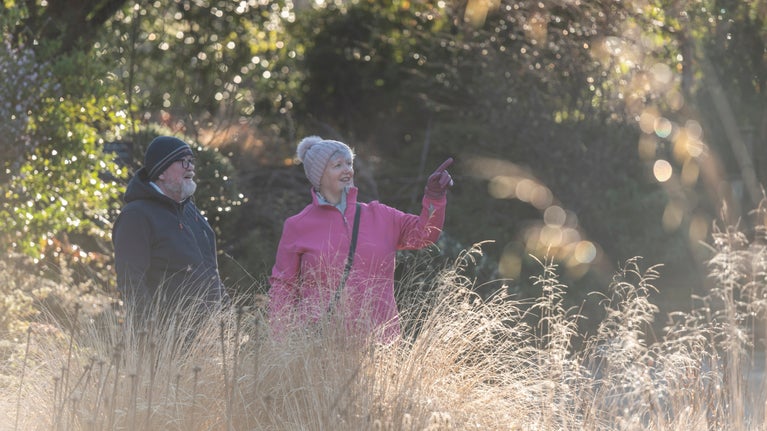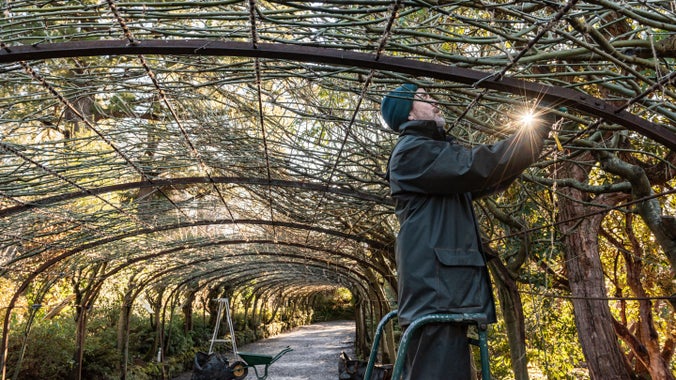
Discover more at Bodnant Garden
Find out when Bodnant Garden is open, how to get here, the things to see and do and more.

Maintaining a historic, horticulturally renowned Grade I listed garden is an all-year round labour of love for our gardeners, garden volunteers and students. Discover how the team work to keep it looking beautiful.
As the ground warms up in spring the team begin weeding, mulching beds with home-made compost, planting and pruning shrubs (including a mass pruning of our famous hydrangeas) and clearing away acres of fallen blossom.
Other major jobs of the spring are deadheading daffodils in the Old Park, when the team gets a much-needed helping hand from volunteers – and weeding the slopes of The Dell, a special task done by gardeners trained in abseiling.
With the warmer, longer days of summer the garden is at its peak and the team are busy deadheading roses, feeding and watering flower borders, cutting and shaping box hedges, summer pruning laburnum and wisteria and mowing, mowing, mowing! Whether it's manicured lawns or wildflower glades and meadows, there's always grass to be cut somewhere on our 80 acre site.
As the leaves turn in autumn gardeners turn their attention to scarifying lawns and renovating turf, tidying herbaceous displays and planting spring bulbs. The end of the season brings the mammoth task of collecting 80 acres of fallen leaves, which go onto our compost heaps.
While many gardens are ‘put to bed’ in the colder season there’s still plenty to do at Bodnant; pruning roses, maintaining the Winter Garden, mucking out the streams which run from top to bottom of the garden, tree work and unglamorous, but essential jobs like re-gravelling paths, repairing drains and fixing rabbit fences.

In the depths of frosty January comes the task of pruning the world-famous Laburnum Arch, which can take two skilled gardeners around six weeks.
The season closes with a big team effort planting snowdrops ‘in the green’. We plant around 20,000 each February in the Old Park meadow, helped by visitors – a great way to mark a new year in the garden.

A large glass nursery, acquired in late 2023 and located adjacent to the garden, has undergone many months of essential refurbishment work to prepare it for use by the garden team.
It will provide four times the current on-site nursery capacity to enable the garden team to propagate and protect Bodnant Garden’s significant plant collection, including the 20th-century rhododendron hybrids bred in the garden that are not available elsewhere. Although the nursery will not be open to visitors, the plants grown inside will, in time, be planted in the garden for all to enjoy.
Ned Lomax, Head Gardener at Bodnant Garden said: “The legacy of any gardener is that many of the trees and shrubs we nurture and plant today will not reach maturity in our own lifetimes. We do what we do now to enable future generations to sit below the branches of these amazing plants, enjoying them for many years to come, and hopefully into the next 150 years at Bodnant Garden.
“The nursery is the engine room of any garden, and this new area will provide Bodnant with four times the amount of space of the previous nursery. It will mean that the team are able to propagate and care for many rare hybrids that simply aren’t available elsewhere.”
It's hoped that the new nursery will enable Bodnant Garden to carry out the entire propagation process for these varieties and many more on site, safeguarding them for future generations to enjoy.
The nursery will not only continue the legacy of Bodnant Garden itself, but also the legacy of the McLaren and Puddle families, whose horticultural skills have given us the garden we know today.
It would not have been possible without a generous gift from the late Bodnant Garden volunteer Dr Rees-Jones. It is thanks to the generosity of visitors, National Trust members and volunteers that this type of work can continue, now and into the future.

Find out when Bodnant Garden is open, how to get here, the things to see and do and more.
Discover how a 'dwelling by a stream' in Snowdonia's foothills grew into a global horticultural haven thanks to generations of the McLaren family and Puddle head gardeners.

Explore the many exotic and rare plants and trees at Bodnant Garden, including five National Collections, as well as Wales’s largest collection of UK Champion Trees.

The garden at Bodnant is the work of generations, starting with the Pochin family and their move from Manchester. Learn about the people who made Bodnant into what we see today.

The fountain, located on the Croquet terrace at Bodnant Garden, is believed to have been created by French sculptor Edmé Bouchardon in around 1700. Today, the fountain’s elaborate oolitic limestone designs have been worn away by decades of running water. You can help us to raise funds to create a new fountain, bringing this area of the five Italianate terraces back to life.